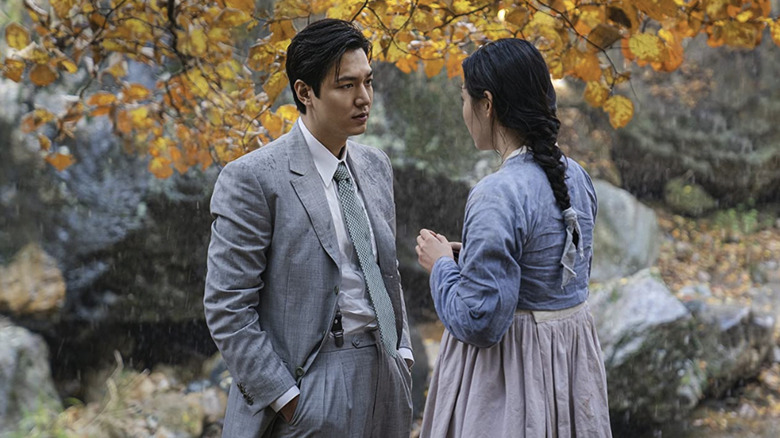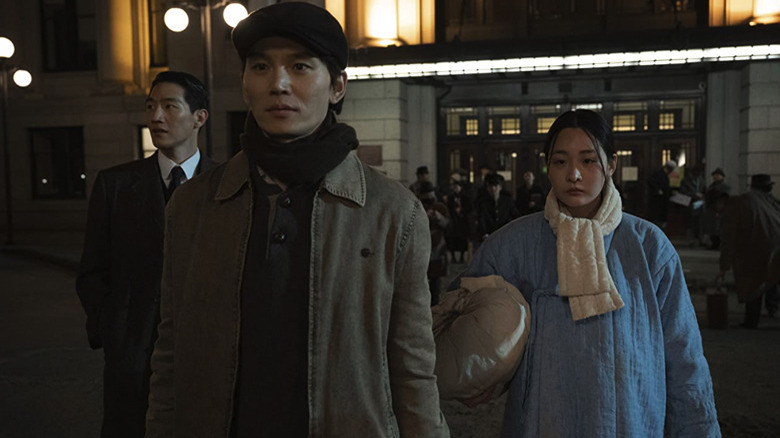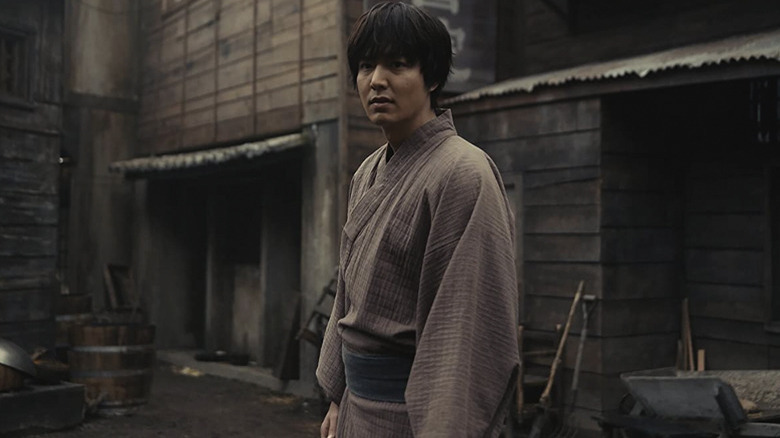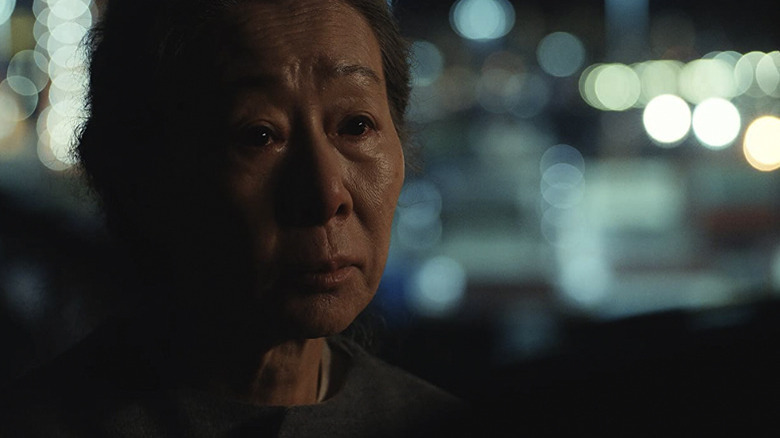Pachinko DP Florian Hoffmeister On Blurring Barriers Through Imagery [Interview]
This article contains mild spoilers for episode 7 of "Pachinko."
Since its debut on March 25, the Apple TV+ series "Pachinko" has granted viewers a portal into the wins and the wounds of the immigrant experience that can reverberate across generations, all shown through its lead character, Sunja (Jeon Yu-na as a kid, Minha Kim as a teen, and Youn Yuh-jung as an adult). If, like me, your verdict on the episodic adaptation of Min Jin Lee's novel has been positive, there's a chance the stirring camerawork has been pivotal in shaping that opinion.
Two cinematographers, Florian Hoffmeister and Ante Cheng, worked on "Pachinko," with the former on episodes directed by Kogonada (1, 2, 3 and 7) and the latter on those by Justin Chon (4, 5, 6 and 8). I had the opportunity to chat with Hoffmeister, and we dove into his experience working on a multicultural project, episode 7's staggering visual change, and aligning perspectives through photography's ability to be universal.
If Hoffmeister's name sounds familiar, you may recognize it because prior to "Pachinko," the German cinematographer and director worked on "Great Expectations" (and won a Primetime Emmy), "The Terror" (and was nominated for an ASC award), and the Guillermo del Toro-produced "Antlers."
This interview has been lightly edited for clarity and brevity.
'I think she's a remarkable writer and an intense showrunner'
How was it working with Soo Hugh again? I think you both first met on "The Terror."
That was indeed a very special collaboration because, as you know, it takes place in the Arctic. Of all places, we had to shoot it in Budapest on a stage. All the lighting was deliberate. The reason I'm saying that is because it was such a partly technically challenging, but also creatively, such a rewarding experience. Of course, you built a lot of trust and also a form of creative language with Soo Hugh and there was another guy, Dave Kajganich. Both of them were co-running the show. I knew that she was working on "Pachinko," and in the most ideal world, something like friendship sustains after the work. I tend not to expect to be asked again, necessarily. I keep a humble distance because there are so many good cinematographers, and there might be a far better choice — somebody who has a different point of view.
So I knew she was working on it but I wasn't really counting on [being involved]. But then she did send me the scripts. I read, and first, I thought, "God, this is so Korean. I don't know what I would bring to the table." But I kept on reading. Then it came to episode 3, where Isak proposes to young Sunja, the idea of taking her to Japan. I thought that scene was so remarkably written. It's such an existentialist point in which the characters find themselves. They find, in that conversation, such a grown-up way of talking about it. Grown-up, for lack of better words, but it was such an adult — they're so young, they have to make a really difficult decision, and they're absolutely adult about it.
"In the Mood for Love" by Wong Kar-Wai — that was a film of my time at film school. That was a milestone in terms of how you could depict love and longing. I thought that scene resonated so much with me. By the time I had read episode 3, I said, "I don't care. I need to shoot this. I want to shoot it."
Then it got quiet for a little while. They had signed Kogonada, and he arranged a phone conversation. We spoke long, and I admire him for his work as a video essayist. I'd seen lots of his stuff. He had also seen a couple of films I shot for the British director Terence Davies, so there was some common ground. Then I got the job! It was good to reunite with her. I think she's a remarkable writer and an intense showrunner. To pull off a show in Korean and Japanese, get it subtitled — that takes some power of will.
What did you learn from trying to ensure that the imagery can cross or blur the cultural or language barriers inherent in this project?
I sometimes say cheekily — it's not really true — but I sometimes say, "I don't even know anymore how to switch on a camera." I try to stay away as far as I can from the technicalities of doing cinematography. That's not necessarily because I'm not interested, but because I think that, especially in digital cinematography, there are so many little details that you can obsess about, information that actually distracts you from what it means to create an image. My core interest is visual intuition and curiosity. That's what motivates me. Of course, it's a gigantic luxury to go to a country that you don't know much about, that you don't understand the language. All of that is terribly stimulating.
When I started working outside of Germany quite early in my career, I shot a lot in Britain, and I could photograph a red telephone booth with the greatest joy, because to me it was foreign. There is that kind of engagement. I think the chance that lies in that is that, in a way, because you are motivated by this curiosity, that it also becomes a vehicle which you can use to transport a foreign viewer into this world. Ideally, you would be motivated by the same curiosity upon looking at this very Korean/Japanese/Asian context, and saying, "Oh!" Then suddenly, you find yourself, after 10 minutes or 15 minutes, already in the story. Suddenly, they're human beings, and it doesn't really matter what their cultural identity is. I think that's how I would define it on a practical level.
Of course, it's challenging because there's a lot of people that speak English very well in Korea. There's been a lot of people who also returned to Korea from the States due to Covid, younger people. We did have [interpreters] with us who were very savvy. But still, for example, my grips, they just didn't speak any English. Everything had to go through [interpreters]. If you have a complicated crane move, where four people move a crane and you wear these Bluetooth headsets and try to communicate with four people at a time, everything has to go through one [interpreter] who also wears the headset. That was a funny procedure!
'I admire 4:3. I think it's a beautiful way of framing things'
I noticed that in the show, you didn't switch up the style between the locations or the timelines. But then there's episode 7, which has more muted colors, a different aspect ratio and this semblance of recovered footage. I really want to know the thought processes or the conversations between you and Kogonada that led to this creative decision.
First of all, I want to credit Soo as a writer, who was adamant that this should always be a standalone endeavor. She was always saying it also has to have a change in aspect ratio. That was partly due to the fact, I think, because that episode tells a story that is not in existence in the original novel. It's something that she really brought to the table as a backstory, how she imagined the backstory of Hansu. She felt very strongly that this backstory needed to be told. In essence, all the conversations we had about how to construct the series and the two timelines, 1920 and 1980, the subjectivity of it, and we wouldn't want to differentiate visually, suddenly we are going outside of that story. We're going outside of the world of Sunja. We're with somebody completely different.
Then we spend an hour with that person, who's also at a completely different point in his life and in a different city. We really wanted to make a point about that. This is a departure, and that's where the aspect ratio came from. The other thought with the aspect ratio was that I admire 4:3. I think it's a beautiful way of framing things. It enables you to limit the canvas and stimulate the imagination of the audience that will, in a way, show a world that only exists in the imagination. I only show you the little square, but I make you feel that the world is endless to the left, right, top, and bottom. Because we couldn't recreate Yokohama after a massive earthquake, we wanted to use the aspect ratio in a way to limit what we really had to show and limit what the audience could imagine.
Ah.
The colors were mostly a reflection of the change in the drama when that earthquake happened. There are some firsthand eyewitness recordings who speak of a very yellow ash, which we then went away from. We went more down to the black and white feel of it. But we really wanted to depict this moment of seizure when this happens, that from one moment to another, the world is destroyed. I, of course, also looked at a lot of 9/11 pictures. There are those quite famous, iconic ones, with a guy on the little chair in the middle of the ash. That's where we motivate ourselves from, this massiveness, the overpowering feeling of this tectonic shift.
I also really appreciate the starkly different choice for that episode because Hansu, to me, is a very forward-momentum kind of person. Even though this story is important to us, the viewer, but maybe from his perspective it's something that he would rather forget.
Hmm, yeah.
It's important to him because that made him who he is, but then it's just too traumatic to remember.
One of my favorite scenes in that episode — I like almost everything in there, but there's the scene where after the earthquake, the night has fallen. There's no light anymore. They get to this place where they ask for sake but they offer tea, then this girl comes around and shakily pouring the tea...
That, to me, is exactly that, a little detail that tells you about the trauma that all these people have gone through. It tells you more than gigantic explosions, how she's pouring the tea. Also, lighting-wise, one of my favorite scenes in that episode.
'You have to get past that admiration that you want for your work'
From all of your works, "The Terror" and most recently "Antlers," it seems like atmosphere is king. From reading "Pachinko," what is the thing that you take from it and try to achieve through your skillset?
That's a good question. Atmosphere, I think that's at the core of cinematography. The performance is shaped by the actor, but the atmosphere in which that performance takes place will subconsciously influence the audience. I've always been really interested in how to contribute to that atmosphere by lighting. Is somebody bright? Is it dark? Is it flat? Is it contrasting? "The Terror" and "Antlers" are, of course, works that, in one way or another, live in the world of horror. The atmosphere there is becoming, almost, a character.
In a piece like "Pachinko," I also think that good cinematography is also — you have to get past that admiration that you want for your work. There's a beautiful saying, "Never put a hat on a hat," so it's also about knowing when to step back and just let it flow. I remember a class at film school that I took with a Polish cinematographer, Sławomir Idziak...
Oh, I love him!
Yeah! He used to say, "Cinematography is only important in the first 10 minutes and the last — because it's the way in and the way out." If Juliette Binoche is crying in minute 50, of course, she has to look beautiful, but in essence, nobody cares about the cinematography at that point. Or nobody should care about it — it should be all about the emotion of the character. I kind of live by that. I thought if we managed to pull something off where people are engaged with it, past its language barrier and by the way it looks, and you evoke a sense of beauty that makes people's hearts resonate, I think then I've done a good job. That was my aim.
"Let it flow" is a really nice approach to have because there's a lot of water, or fluid-like imagery, in "Pachinko." I think the shot that I'm still remembering now is young Sunja and her dad playing in the field. There's just a very gentle movement to it that makes it all very poetic. In terms of memory, that is a very different memory compared to Hansu's in episode 7.
Yes, true. That probably is a good way of looking at the differences in character. I guess from the way you put your questions, I assume you're an optimist as much as you are a realist. Let's say the power in which she endures and motivates herself through all these changes that life throws at her, I think that power stems from the fact of that poetry she has experienced as a child. Whereas him having experienced that kind of trauma ... failure is, in a way, an emotional failure is something that is almost determined for him. Let's hope that the beauty makes people good people!
How is your project "Tár" coming along? What can photography-minded filmgoers expect from you for that project?
I haven't seen any edits yet. We finished principal photography, which took place from, I think, September last year until December. Todd Field is a very, I thought, a fantastic filmmaker to work for and with. It's going to be completely different. It's not poetic at all. Everything we said all day, the mantra was "never gild the lily." Just don't throw it away, don't be poetic, don't put a hat on a hat even further. I think it has a very beautiful central performance from Cate Blanchett. I hope it will be a fantastic film. It comes out in October, I think.
That is very nice. I think I missed that October release date while I was searching for it.
I think that's the aim. It should come out this year. I don't want to spoil the plot because I think it's kept under wraps, but Cate Blanchett is the conductor of a very big German orchestra. It's a fantastic story and I really think a very important commentary on our current cultural environment in which we operate.
Update: Some information about "Tár" has been removed from this interview at the request of Mr. Hoffmeister.
The first season of "Pachinko" is streaming now on Apple TV+.



